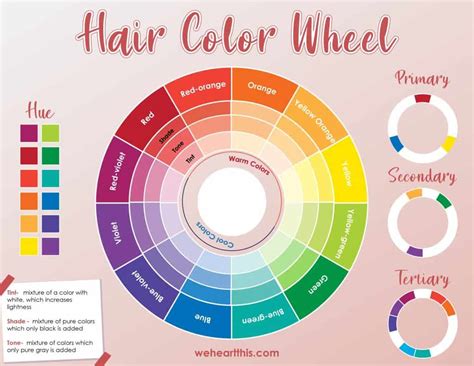Are you ready to embark on a transformative hair color adventure? Let the hair color wheel be your guide as you navigate the vast spectrum of shades and tones. With its infinite possibilities, the hair color wheel empowers you to create a look that’s uniquely you.

Understanding the Hair Color Wheel
The hair color wheel is a visual representation of the color spectrum, divided into primary, secondary, and tertiary colors. It’s analogous to the color wheel used in painting and design.
Primary Colors: Red, Yellow, Blue
These are the purest colors and cannot be created by mixing other colors. Red is known for its warmth, yellow for its brightness, and blue for its cool undertones.
Secondary Colors: Orange, Green, Violet
These are created by mixing two primary colors:
- Orange: Red + Yellow
- Green: Yellow + Blue
- Violet: Red + Blue
Tertiary Colors: Blue-Violet, Red-Violet, Blue-Green, Yellow-Green, Red-Orange, Yellow-Orange
These are created by mixing a primary color with a secondary color:
- Blue-Violet: Blue + Violet
- Red-Violet: Red + Violet
- Blue-Green: Blue + Green
- Yellow-Green: Yellow + Green
- Red-Orange: Red + Orange
- Yellow-Orange: Yellow + Orange
Choosing Your Hair Color
Selecting the perfect hair color depends on several factors, including your skin tone, eye color, and natural hair color.
Skin Tone
- Warm skin tones: Warm colors like red, orange, and gold flatter warm skin tones.
- Cool skin tones: Cool colors like blue, green, and purple complement cool skin tones.
- Neutral skin tones: Luckily, nearly all colors suit neutral skin tones.
Eye Color
- Brown eyes: Browns, golds, and reds enhance brown eyes.
- Blue eyes: Cool tones like blues, greens, and purples bring out the contrast in blue eyes.
- Green eyes: Browns, reds, and oranges emphasize the warmth in green eyes.
- Hazel eyes: Experiment with various shades to find the perfect match for your unique eye color.
Natural Hair Color
- Blondes: Hair color wheels with lighter values are ideal for blondes.
- Brunettes: Hair color wheels with darker values are suitable for brunettes.
- Redheads: Natural redheads should choose shades with orange or copper undertones.
Tips for Choosing the Right Hair Color
- Consult a professional hairstylist for personalized recommendations.
- Consider your lifestyle and maintenance needs. Some colors require more upkeep than others.
- Experiment with temporary hair dyes or clip-in extensions to preview potential shades.
- Remember that hair color trends change frequently, so choose a color you’ll feel confident in long-term.
Tricks for Dyeing Your Hair
- Use a hair color wheel to ensure you’re choosing the right shade.
- Follow the instructions on the hair color box carefully.
- Wear gloves to protect your hands.
- Apply the dye to clean, dry hair.
- Leave the dye on for the recommended amount of time.
- Rinse your hair thoroughly and condition deeply.
- Use color-protecting shampoos and conditioners to maintain your new hue.
Pros and Cons of Hair Color
Pros:
- Transform your look: A new hair color can instantly change your appearance.
- Boost your confidence: Finding a flattering color can make you feel more confident and stylish.
- Cover gray hair: Hair color effectively hides gray hair and restores a youthful appearance.
- Express yourself: Your hair color can be a form of self-expression and creativity.
Cons:
- Damage: Chemical hair dyes can damage your hair if not used correctly.
- Maintenance: Some colors require frequent touch-ups to maintain their vibrancy.
- Cost: Professional hair coloring services can be expensive.
- Allergic reactions: Some people experience allergic reactions to hair dyes.
Creative Applications of Hair Color
Beyond traditional hair coloring, the hair color wheel has inspired numerous innovative applications:
- Color blocking: This technique involves dividing your hair into sections and dyeing each section a different color.
- Ombré: A gradual transition from one color to another, typically from dark to light.
- Balayage: Hand-painted highlights that create a natural, sun-kissed look.
- Colormelt: A seamless blending of two or more colors, creating a gradient effect.
Tables for Easy Reference
Table 1: Primary, Secondary, and Tertiary Colors
| Color | Code |
|---|---|
| Red | R |
| Yellow | Y |
| Blue | B |
| Orange | O |
| Green | G |
| Violet | V |
| Blue-Violet | BV |
| Red-Violet | RV |
| Blue-Green | BG |
| Yellow-Green | YG |
| Red-Orange | RO |
| Yellow-Orange | YO |
Table 2: Skin Tone Recommendations
| Skin Tone | Flattering Colors |
|---|---|
| Warm | Red, Orange, Gold |
| Cool | Blue, Green, Purple |
| Neutral | Nearly all colors |
Table 3: Eye Color Recommendations
| Eye Color | Flattering Colors |
|---|---|
| Brown | Browns, Golds, Reds |
| Blue | Blues, Greens, Purples |
| Green | Browns, Reds, Oranges |
| Hazel | Experiment with various shades |
Table 4: Natural Hair Color Recommendations
| Natural Hair Color | Suitable Hair Color Wheels |
|---|---|
| Blonde | Lighter values |
| Brunette | Darker values |
| Redhead | Shades with orange or copper undertones |
